

![]()
OTHER
|
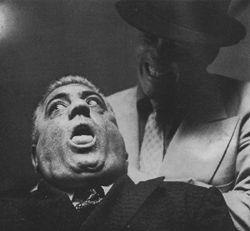 |
TONY ROSE |
Discusses the not-so-gentle art of screen murder as practiced in The Godfather but finds that the film's golden moments owe nothing to the director's insistence on showing every act of violence in graphic detail |
Reproduced from the November 1972 issue of Movie Maker.
WHEN you see The Godfather - and if it proves to be as popular here as it has done in the USA, you almost certainly will be seeing it - spare a thought for the gangster films of old. Films in which James Cagney, Edward G. Robinson and Humphrey Bogart spat out their dialogue like used chewing gum and filled each other up with lead at the droop of an eyelid.
In the days of our youthful innocence those monochromatic melodramas seemed like the last word in ruthless realism. Shot as they often were in real city locations and stuffed with documentary details about police procedure and racketeering methods, they convinced us that the producers were living up to their own advertising slogans and actually taking the lid off America's underworld.
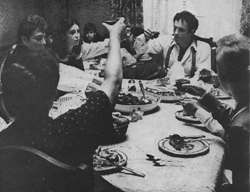 If it does nothing else, The Godfather shatters that illusion. It reveals those vintage crime flicks for what they were -
fantasies as stylised as ballet and just about as closely related to anything that goes on in real life. (Cagney indeed
played his death scenes very much like a ballet dancer, staggering and twitching for minutes on end through a rain
of mythical machine gun bullets.) The characters now seem picturesque and even likeable eccentrics, their crimes
mere swashbuckling adventures.
If it does nothing else, The Godfather shatters that illusion. It reveals those vintage crime flicks for what they were -
fantasies as stylised as ballet and just about as closely related to anything that goes on in real life. (Cagney indeed
played his death scenes very much like a ballet dancer, staggering and twitching for minutes on end through a rain
of mythical machine gun bullets.) The characters now seem picturesque and even likeable eccentrics, their crimes
mere swashbuckling adventures.
The Godfather, as everyone must know by now, purports to tell the inside story of a Mafia 'family' of which Don Vito Corleone (Marlon Brando) is the father figure and elder statesman. Directed by Francis Ford Coppola with extreme technical efficiency, it provides us with a knowing and sophisticated picture of gangsterdom as a sordid and bloody business - with the accent very much on the blood as well as the business.
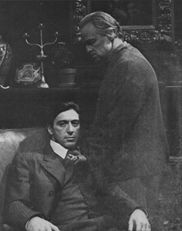 Looking at it objectively, one has to admit that it is probably a good deal more true to life than any of the old Cagney
capers. And no doubt the director would argue that this makes it more honest and gives it a better claim to be
considered as a serious work of art. Yet somehow, while I was watching it, I found it less persuasive, less gripping
than, say, The Roaring Twenties or White Heat.
Looking at it objectively, one has to admit that it is probably a good deal more true to life than any of the old Cagney
capers. And no doubt the director would argue that this makes it more honest and gives it a better claim to be
considered as a serious work of art. Yet somehow, while I was watching it, I found it less persuasive, less gripping
than, say, The Roaring Twenties or White Heat.
This raises an interesting point about the relationship between realism and credibility namely that greater realism does not necessarily make for greater credibility.
When we watch a film we all, to some extent, become voluntarily credulous. We surrender ourselves to the director's imagination and allow him to transport us into the past or future, to transfer us instantly from a hotel room to an aircraft in flight or whatever. When the hero is stranded on a desert island, we accept that he really is stranded and forget the presence of the camera crew.
If it were not for this unwritten agreement between the audience and the film maker to 'suspend disbelief', the cinema would not work at all. Sometimes, of course, the spell is broken by some obvious artificiality - a line of dialogue that rings false, a bit of ham acting or even a jump cut. But in general it's amazing how much we can swallow: in musicals we don't even balk at a cowboy singing in tune and in time with an unseen orchestra while riding a horse at full gallop.
I've just been reading a new book called Film as Film by V. F. Perkins (Penguin Books, 35p) in which the author castigates certain directors for spoiling the illusion of reality by over indulgence in arty stylisation. One example he quotes is a scene in Moulin Rouge when John Huston flooded the set with green light to symbolise Toulouse Lautrec's jealousy. This, I would agree was such an obtrusive effect that it drew attention to the technique being used rather than to the emotion it was supposed to suggest.
But if stylisation can go too far, so can realism-and this, to my mind, is the weakness of The Godfather. Perhaps it's just a personal peculiarity but the sight of blood does something to me physically. When I see a lot of it being spilled in colour on the screen, some little defence mechanism is triggered off in my brain which reminds me that I am only watching a movie, that the people it it are only actors and that the gore they are shedding so generously is strictly ersatz.
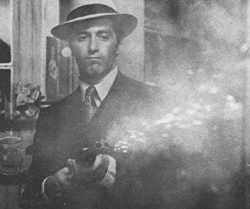 Paradoxically perhaps, I can believe in a killing if it takes place off screen or in long shot or if it is suggested by
montage like the shower bath murder in Psycho. It's only when bullet holes appear in human flesh before my eyes
that I switch off my suspension of
disbelief and absorption in the story gives way - temporarily at least, to admiration for the special effects
department. This happened all
too frequently in The Godfather.
Paradoxically perhaps, I can believe in a killing if it takes place off screen or in long shot or if it is suggested by
montage like the shower bath murder in Psycho. It's only when bullet holes appear in human flesh before my eyes
that I switch off my suspension of
disbelief and absorption in the story gives way - temporarily at least, to admiration for the special effects
department. This happened all
too frequently in The Godfather.
Perhaps I can underline the point with a direct comparison. In White Heat there is a callous scene involving a stool pigeon who has been locked into the boot of the gangsters, car. Cagney, as the gang chief, is munching a cheese sandwich when he is reminded of the prisoner's existence by muffled sounds of protest coming from the boot.
"Want some more air in there?" he asks casually and, on hearing a strangled affimative, pulls out his revolver and pumps three shots through the metalwork. The shattering explosion, followed by a deathly silence had a truly chilling effect and gave no cause to doubt that unseen man had died there in the darkness.
Because the actual death is unseen, credulity is unstrained and we remain where the director, Raoul Walsh, wants us locked within the illusion of reality that we tacitly agreed to inhabit when we entered the cinema.
In The Godfather practically nothing is unseen. Quite deliberately but, as I think, mistakenly, Coppola makes every act of violence explicit - and the acts include two garottings, various savage punchings and kickings and the fairly prolonged beating of a lady with a leather belt.
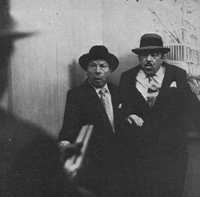 Consider the way he handles a shooting scene that aims for the same kind of shock effect as the one in White Heat. A
casino proprietor in Las Vegas has defied the Corleone family and we have reason to suspect that he has been
marked down for assassination. We cut to him in medium close-up as he relaxes in a massage
parlour. From off screen we hear
the sound of a disturbance and a door being thrust open.
Consider the way he handles a shooting scene that aims for the same kind of shock effect as the one in White Heat. A
casino proprietor in Las Vegas has defied the Corleone family and we have reason to suspect that he has been
marked down for assassination. We cut to him in medium close-up as he relaxes in a massage
parlour. From off screen we hear
the sound of a disturbance and a door being thrust open.
The casino proprietor looks up and puts on his spectacles. Off screen again, we hear a gun being fired and one of his spectacles lenses shattered. From behind the broken lens blood gushes out and pours down his cheek.
That's it. The whole episode is covered in one take with the camera trained inflexibly on the victim throughout. Of course, it's brilliantly done and doesn't look like a fake but the very fact that its shown head-on in such graphic detail forces us to realise that it must be a fake.
As I hinted before, this could be a personal reaction. It's possible that those who are less allergic to blood than I and less aware of the way films are made will be able to take everything in their imaginative stride. But I doubt it.
In America, I'm told, audiences have been giving a round of applause to each of the many killing scenes. This could betoken a sophisticated appreciation of the technique of special effects or - nasty thought - a real liking for murder as an entertaining spectacle in its own right. In either case, it seems to me to be a sign of artistic failure, since the director's reason for making the violence so explicit was presumably to make it more horrifying.
However, I have laboured this point long enough and in fairness I should also emphasise that in other respects Mr Coppola provides us with ample evidence that he knows what he's doing. The Godfather was a very long novel with more episodes and more characters than can be comfortably accommodated in a movie but Coppola's screenplay, written in collaboration with the original author, Mario Puzo, largely overcomes the problem.
It establishes the key people and their relationships firmly and swiftly with a minimum of explanatory dialogue and has a strong narrative drive that carries us along from scene to scene without pause or diversion. At times it makes a story point all the more effectively by almost throwing it away.
In one sequence, for example, a Corleone henchman is dispatched to Hollywood to persuade a film producer that an up-and coming young actor, who is also a member of the clan, deserves a plum part in the producer's new picture. The producer refuses point blank and the henchman politely takes his leave.
Later the producer wakes up in the middle of the night to find his bed sheets soaked in blood. Turning back the covers, he finds that the severed head of his favourite racehorse has been tucked in with him. Cut back to an exterior shot of the house over which we hear a single piercing scream. Fade out.
That apparently is the end of the episode for the next sequence takes us back to the Corleone headquarters where other business is under discussion. However, the outcome is neatly revealed when the meeting is momentarily interrupted by the delivery of a large basket of flowers, accompanied by a cordial greeting from a young actor, announcing that he has just been cast in his first star role.
Although he has a lot of plot to unfold, Coppola does not neglect atmosphere. The almost suffocating warmth and closeness of Italian family life are faithfully captured with babies constantly crying and large quantities of pasta constantly being consumed. We can almost smell the garlic and the urine.
Above all, we are never allowed to forget the film's unifying theme which is that the Mafia family derives its strength from a sense of moral rectitude. They do not see themselves as criminals but rather as a minority group - a nation within a nation - that has had to fight to stay alive and, in doing so, has formed its own peculiar code of ethics.
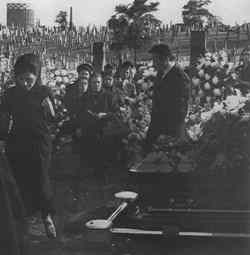 Racketeering is
their business and they pursue their business diligently, using terror as a necessary tool of the
trade. For the rest, they are much concerned with honour and loyalty, respect their elders and are kind to their
children.
Racketeering is
their business and they pursue their business diligently, using terror as a necessary tool of the
trade. For the rest, they are much concerned with honour and loyalty, respect their elders and are kind to their
children.
The paradox is underlined - perhaps a little too blatently - in the film's climax which intercuts the baptism of the latest Corleone offspring with scenes of gang warfare. But it is embodied with far greater subtlety in the performance of Marlon Brando as Don Corleone, the patriarchal head of the family until he is superseded in his declining years by his son, Michael (Al Pacino).
Indeed, the best reason for seeing The Godfather is that it provides Brando (at last) with a part that is worthy of his abundant attributes. He has intelligence plus intuition plus physical magnetism and he deploys them all here to enormous effect. While the camera is pointing at him, there is never a dull moment and even when he is off screen as he is for nearly a third of the picture, following a near-fatal wounding incident we somehow feel his presence and anxiously await his return.
The way that he adopts the tired mannerisms of old age and the thin, croaking voice- suggesting that he has undergone a throat operation-are admirable of course but these could be managed by many a competent actor. Where Brando is concerned, they are merely the surface decorations of a deeply understood characterisation; he makes us see the man underneath a wicked old villain who is all the more sinister because, according to his own standards, he is something of a family saint. Without sentimentalising; the role, he shows us that Don Corleone's strength is as the strength of ten because his heart is pure.
Two scenes in particular will stay in my mind as supreme examples of creative acting and the art that conceals art. In the first Corleone is presiding over a family conference while he sits at his desk, nursing and caressing a cat. Notice here the cat's sensuous enjoyment of Brando's touch and notice too how Brando reacts to the cat's movements, punctuating his conversation naturally as he pays slight attention to it.
Traditionally, animals are feared by actors because of their capacity for scene stealing. But here, in a sense, the tables are turned. Brando uses the cat's natural behaviour as an extension of his own performance, making it look more spontaneous and helping us to forget that he is speaking lines learned from a script.
The same idea is carried further in a sequence towards the end of the film which leads up to Corleone's death. Again Brando is teamed with a non-actor - in this case a small child. The old man is playing with his grandson in the garden. He has been eating an orange and, taking a piece of the peel, he inserts it in his mouth with the white pith outwards so that it looks like a set of gruesome fangs.
Thus transfigured, he turns suddenly on the boy whose face we see over his shoulder. For an instant the child's expression is one of terror and then, realising in a flash that it is only his grandfather playing a trick, it changes and he begins to laugh.
This is one of those golden unrepeatable moments -not an acted emotion but the stuff of life itself - a moment such as every family film maker may hope to capture once in a lifetime. It could not be simulated or rehearsed and it would be very difficult to engineer in advance. Yet in this instance, to fit into the story situation, it must have been engineered by Brando who sparked off the lad's reaction.
As he himself plays the scene back to camera, it must be classed as one of the most unselfish as well as the most brilliant acting achievements of all time.
| Just click on one of the images to see the larger version. | ||
 |
 |
 |
|
The killings in The Godfather are shown head-on and usually in close-up. Witness this garotting of one of the Corleone 'family' by a rival gangster. |
As a kind of counterpoint to the scenes of terror and violence the film stresses the closeness and warmth of the Corleone home life, typified by the frequent consumption of large meals. |
The Godfather himself, Don Corleone played by Marlon Brando, with his son and heir, Michael played by Al Pacino. |

|

|
 |
|
More violence as Corleone henchmen wipe out their rivals in the film's climatic blood bath. As these stills indicate, the casting to physical type in each minor role is impeccable. |
A funeral - Mafia style. Don Corleone has died (almost incredibly of natural causes) and his business acquaintances turn out in force to mourn him, while more mayhem is already being plotted at the graveside. Soon business will be back to normal. |
|
IMPORTANT NOTICE
|
![]()
This page was last updated 02 Dec 2002